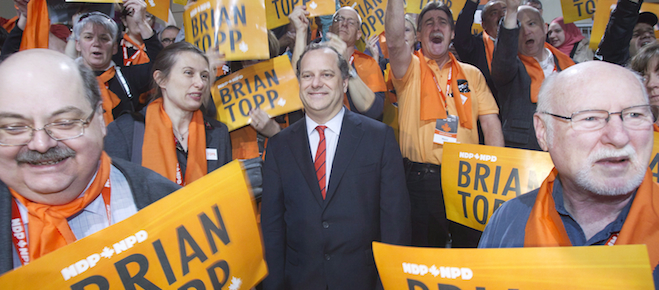The Topp memos
The NDP campaign director explains everything
NDP leadership candidate Brian Topp cheers with supporters during the NDP leadership convention in Toronto on Saturday, March 24, 2012. THE CANADIAN PRESS/Frank Gunn
Share

Via Alice Funke, a pair of rather remarkable documents: an early draft and a final draft of Brian Topp’s assessment of the campaign run by the BC NDP in that province’s most recent election.
Mr. Topp, the former campaign director and leadership contender for the federal NDP, was campaign director for the BC NDP and his memos would seem to lay out all the mechanics, considerations and thinking of a modern political campaign—or at least all which Mr. Topp was willing to commit to paper. There are, for instance, three full sentences about the choice of campaign music.
Campaign music should be chosen for thematic and musical purpose. It should be captivating and excite the crowd and it should help tell the story. It could also be changed at specific times to indicate a shift or emphasize something specific about a particular location or issue.
Here’s Mr. Topp on message discipline and media relations.
Delivering a Consistent Message
In focus groups held in the mid-way point of the campaign, our target voters were asked to recall the core campaign messages for the two main parties. Many participants quickly and easily identified that Christy Clark and the BC Liberals’ main message was “jobs” and the “economy.” But when it came time to recall what Adrian Dix and the BC NDP’s message was, no participant could do so. These voters had recalled hearing something from the leader and the party but could not articulate its central overall message. Lessons learned and recommendations for delivering a consistent and penetrating message:
Prepared Speeches and Daily Message
The Leader is the campaign’s most powerful message-delivery vehicle. To succeed, the message delivered over 28 days must be unambiguous, crisp, direct, and repetitive. Christy Clark succeeded by using every opportunity to deliver her message, over and over again in her prepared remarks, in one-on-one interviews and in answering questions from the media.
Despite media claims to have disliked the repetitive nature of Clark’s message, they nevertheless reported it faithfully(and it was therefore digested by the voters). Our Leader’s remarks were almost exclusively extemporaneous and often contained several ideas competing for space. In the absence of a daily message guide, candidates, spokespeople and campaign workers had no guide as to what our story in the campaign was, so there wasn’t one.
In modern campaigns with so many channels for voters to consume information, it is vital that a
consistent message is delivered in all channels. Next time, our Leader should follow a tight, focused, brief, and consistent message through prepared speeches at every opportunity. A daily message guide containing talking points should be reviewed,internalized and repeated every day by the leader, candidates and by all who were working on thecampaign.Exposure to Media on Tour
A leader’s answers to questions by the media need to be concise and repetitive in order to be clipped, used and thereby heard by the voter. Detailed and wide-ranging answers don’t ensure the message is heard by the intended audience. Communicating like this hands control of the campaign’s message to the media as they get to choose what the message is.
Exposure through tour scrums should be kept to a minimum in order for the Leader’s message of the day to carry though to air and print time. Holding three or four scrums a day ensures that the intended message of the day gets lost in the myriad other things the media want to ask.
The Leader should also resist the temptation to engage in commenting on the strategy of the campaign or predicting what may or may not happen. The Leader should not engage in punditry.
The job of media relations is to help guide and shape the media’s interaction with the Leader in a way that best controls the narrative and the message in the interests of the campaign. This requires considerable discipline and control over the media’s access to the Leader. Ad hoc, one-off interviews — unless they are feature length or in-depth sit down sessions — should be strictly limited. Scrums should be managed with a “chair” to assign questions and a strict limit of the number of questions. TheLeader’s answers should be short and repetitive.
Scrums on the leader’s tour during a campaign should be brief, rare and generally focused on repeating the message of the day.
So that’s how your discourse is properly managed in 2013.
Chantal Hebert sees a future NDP that has more in common with Stephen Harper than Jack Layton. Maybe. This approach to media management is the sort of thing these people would probably understand. But the NDP’s 2011 campaign was not all hugs and smiles. There were, for instance, ads like this and this and this and this and this. And during the federal leaders’ debate, there was this.
In the summation of his earlier draft, Mr. Topp sets out three things the next campaign must do.
We must do a much more effective job of discrediting our opponent, each and every day of the campaign, when most people are paying attention to politics;
We must defeat, or at least fight to a draw, whoever our conservative opponent is on core economic issues; and
We must offer a campaign than people like; engage with; are inspired by; turn out to participate in; and are motivated to vote for – even after another immersion in our opponent’s darkest arts.
The NDP’s 2011 campaign defies easy comparison—and I didn’t see enough of the BC NDP’s campaign to know how it met or failed to meet this ideas—but this sounds something like that federal effort.